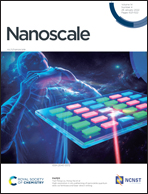An aptamer-tethered DNA origami amplifier for sensitive and accurate imaging of intracellular microRNA†
Abstract
Accurate detection and imaging of low-abundance microRNA (miRNA) in living cells are essential for the diagnosis and prognosis of diseases. Designing nanoprobes with resistance to enzyme degradation, effective cell-binding, and efficient signal amplification is crucial for in vivo imaging. In this study, we present an aptamer-tethered DNA origami amplifier (ADOA) that functions inside living cells to detect miRNA with high sensitivity and stability. In the design, cancer cell-targeting aptamers were tethered onto the border of the DNA origami to improve the discrimination between cancer cells and normal cells. Two substrate modules for the intramolecular entropy-driven reaction (EDR) circuit were alternately arranged on the DNA origami plane. The target miRNA will initiate the sequential hybridization of the two substrate modules on the DNA origami, generating amplified fluorescence signals. The proposed ADOA achieved an accelerated cascade reaction due to the “confinement effect” and significantly enhanced the sensitivity compared with a traditional EDR. Meanwhile, with the rigid structure of the DNA origami, the ADOA possessed excellent signalling stability in living cells. Therefore, the ADOA could expand the application of DNA origami in miRNA sensing and has potential value in early-stage clinical diagnosis.



 Please wait while we load your content...
Please wait while we load your content...